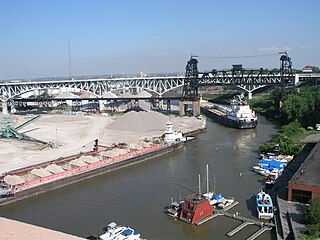
A platform supply vessel (PSV) is a ship specially designed to supply offshore oil and gas platforms and other offshore installations. They typically range from 50 to 100 metres in length and are distinguished by the large open deck area used to store supplies and house equipment and to allow for efficient loading and offloading. The primary function for most of these vessels is logistic support and transportation of goods, tools, equipment, and personnel to and from their destination.
Biruința, renamed Iris Star and later Histria Crown, is a Romanian crude oil tanker.

MT Petali is an Aframax crude oil tanker. Formerly known as Mastera for almost two decades and briefly as Mikines in early 2022 and Alma until September 2023, she and her sister ship Tempera were the first ships to utilize the double acting tanker (DAT) concept in which the vessel is designed to travel ahead in open water and astern in severe ice conditions. The icebreaking tanker was built to transport crude oil year-round from the Russian oil terminal in Primorsk to Neste Oil refineries in Porvoo and Naantali.

La Noumbi is a floating production storage and offloading (FPSO) unit operated by Perenco. The vessel, converted from the former Finnish Aframax crude oil tanker Tempera by Keppel Corporation, will replace an older FPSO unit in the Yombo field off the Republic of Congo in 2018.

The landing craft mechanized (LCM) is a landing craft designed for carrying vehicles. They came to prominence during the Second World War when they were used to land troops or tanks during Allied amphibious assaults.

Ralph J. Scott, also formerly known as Fireboat #2, is a 100-foot (30 m) fireboat that was attached to the Los Angeles Fire Department serving the Port of Los Angeles. She was retired in 2003 after 78 years and replaced by Warner L. Lawrence. Ralph J. Scott is undergoing restoration near the Los Angeles Maritime Museum in San Pedro. On 30 June 1989, she was listed as a National Historic Landmark. She is currently located at the Los Angeles Fire Department, Fire Station 112, at 444 South Harbor Blvd, Berth 86, San Pedro, California.
MT Independența ("Independence") was a large Romanian crude oil carrier. She collided in 1979 with a Greek freighter at the southern entrance of Bosphorus, Turkey, and exploded. She caught fire and grounded. Almost all of the tanker's crew members died. The wreck of the Independența burned for weeks, causing heavy air and sea pollution in the Istanbul area and the Sea of Marmara.
The Port of Constanța is located in Constanța, Romania, on the western coast of the Black Sea, 179 nautical miles (332 km) from the Bosphorus Strait and 85 nmi (157 km) from the Sulina Branch, through which the Danube river flows into the sea. It covers 3,926 ha, of which 1,313 ha is land and the rest, 2,613 ha is water. The two breakwaters located northwards and southwards shelter the port, creating the safest conditions for port activities. The present length of the north breakwater is 8,344 m (5.185 mi) and the south breakwater is 5,560 m (3.45 mi). The Port of Constanța is the largest on the Black Sea and the 17th largest in Europe.
Histria Agata is a chemical/oil products tanker owned by the Romanian shipping company Histria Shipmanagement and is registered in Valletta, Malta.
Histria Coral is a chemical/oil products tanker owned by the Romanian shipping company Histria Shipmanagement and is registered in Valletta, Malta.

Histria Ivory is a chemical/oil products tanker owned by the Romanian shipping company Histria Shipmanagement and is registered in Valletta, Malta.

Histria Giada is a Chemical/Oil Products Tanker owned by the Romanian shipping company Histria Shipmanagement and is registered in Valletta, Malta.

Histria Tiger is a Chemical/Oil Products Tanker owned by the Romanian shipping company Histria Shipmanagement and is registered in Monrovia, Liberia.
Histria Azure is a Chemical/Oil Products Tanker owned by the Romanian shipping company Histria Shipmanagement and is registered in Majuro, Marshall Islands.
Histria Prince is a Chemical/Oil Products Tanker owned by the Romanian shipping company Histria Shipmanagement and is registered in Majuro, Marshall Islands.
Histria Topaz is a Chemical/Oil Products Tanker owned by the Romanian shipping company Histria Shipmanagement and is registered in Majuro, Marshall Islands.
Histria Diamond is a Chemical/Oil Products Tanker owned by the Romanian shipping company Histria Shipmanagement and is registered in Valletta, Malta.
MT Unirea was a Romanian-flagged crude oil carrier, one of the biggest ships of the Romanian commercial fleet. She broke up and sank in 1982 in the Bulgarian waters of the Black Sea, 40 nautical miles (74 km) south-south east of the Cape Kaliakra at a depth of 1,400 metres (4,600 ft) after a mysterious explosion. The crew totalled 43 members of which 42 were rescued by Romanian and Soviet boats. The sinking of Unirea was classified by Lloyd's List as the largest ship accident of 1982.

Algoma Buffalo, formerly Buffalo, is a diesel-powered lake freighter acquired by Algoma Central Corporation in 2018. This vessel was built in 1978 by Bay Shipbuilding Company at their yard in Sturgeon Bay, Wisconsin for the American Steamship Company and included self-unloading technology. The ship is 634 feet 10 inches (193.50 m) long and 68 feet (21 m) wide, with a carrying capacity of 24,457 tons deadweight (DWT), and is primarily used to ship road salt and construction goods. The vessel is currently in service.
MV Damia Desgagnés is an asphalt-bitumen-chemical tanker owned and operated by Groupe Desgagnés for service on the Saint Lawrence Seaway. The ship was completed in March 2017. Damia Desgagnés is the first Canadian-flagged tanker to have a duel-fuel-powered propulsion system. The first of four ships of such a design, Damia Desgagnés ran aground on its first trip through the Saint Lawrence Seaway.








